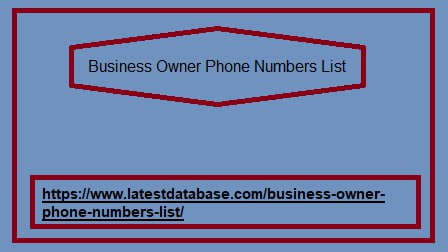Post by account_disabled on Feb 25, 2024 5:22:16 GMT
When conducting an advertising campaign, marketers generously pour links to target pages through all available channels: in contextual advertising, in banners, in social networks and email newsletters. Think about it: there is one link, but there are many options for its placement . The number of tested banners and creatives in social networks is limited only by the time, imagination and budget of the person doing it. At the campaign optimization stage, there is an urgent need to understand traffic sources. The link itself cannot give an expert an idea of where the user accessed it — saw an ad on Facebook or clicked on a link in an e-mail. However, the guys from the companyUrchinfound a way to "talk" URLs.
They came up with the idea of installing a "beacon" on each link of the advertising campaign , which would record information about the user's Business Owner Phone Numbers List actions and transfer them to the analytics system. "Beacons" were named Urchin Tracking Module — Urchin tracking module (abbreviated as UTM). And the link "spoke". Content: What are UTM tags and why are they needed? Types of UTM tags. Dynamic UTM tags Recommendations for compiling UTM tags UTM tag generators Conclusions 7 recommendations for compiling UTM tags. Types, methods of use, useful UTM generators Read also : 7 steps to the perfect meta description What are UTM tags and why are they needed?

UTM tags are an addition to the URL of a page that collects data about the actions of users who clicked on a link, and then the tags send this information to an analytics system for processing. A link without a UTM tag looks like this: The link without the UTM tag looks like this Everything we see in the screenshot below, after the “?” in addition to a normal URL is a UTM tag. Everything we see in the screenshot below, after the “?” in addition to a normal URL is a UTM tag. The label allows you to find out from which advertising site the user came, what actions he took after the transition, for which keyword the link appeared in the search results. Importantly! The target site must be connected to the analytics system —Google Analytics or Yandex.Metrica.Otherwise, the label data cannot be processed.
They came up with the idea of installing a "beacon" on each link of the advertising campaign , which would record information about the user's Business Owner Phone Numbers List actions and transfer them to the analytics system. "Beacons" were named Urchin Tracking Module — Urchin tracking module (abbreviated as UTM). And the link "spoke". Content: What are UTM tags and why are they needed? Types of UTM tags. Dynamic UTM tags Recommendations for compiling UTM tags UTM tag generators Conclusions 7 recommendations for compiling UTM tags. Types, methods of use, useful UTM generators Read also : 7 steps to the perfect meta description What are UTM tags and why are they needed?

UTM tags are an addition to the URL of a page that collects data about the actions of users who clicked on a link, and then the tags send this information to an analytics system for processing. A link without a UTM tag looks like this: The link without the UTM tag looks like this Everything we see in the screenshot below, after the “?” in addition to a normal URL is a UTM tag. Everything we see in the screenshot below, after the “?” in addition to a normal URL is a UTM tag. The label allows you to find out from which advertising site the user came, what actions he took after the transition, for which keyword the link appeared in the search results. Importantly! The target site must be connected to the analytics system —Google Analytics or Yandex.Metrica.Otherwise, the label data cannot be processed.
